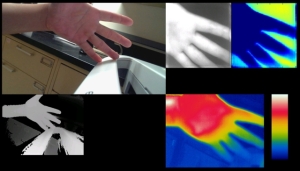by
Lauren Dubinsky, Senior Reporter | March 23, 2015

Top-Left: Visual RGB Image
Bottom-left: 3D Image
Top-right: Multi-spectral Imaging and
Recovered Feature Map
Bottom-right: Thermal Imaging
Courtesy of GE Global Research
Scientists at GE Global Research, the research and development division of GE, have developed a new hand-held probe to detect and prevent pressure ulcers. It was born out of a joint project with the U.S. Department of Veterans Affairs (VA) Center for Innovation.
Every year, over 2.5 million people in the U.S. develop pressure ulcers, according to the Agency for Healthcare Research and Quality. CMS is no longer reimbursing hospitals to care for a patient who developed a pressure ulcer while in the hospital.
“Pressure ulcers are a very pervasive, but also very preventable condition for hospital patients,” Ting Yu, principal Investigator on pressure ulcer prevention and care program, said in a statement.



Ad Statistics
Times Displayed: 173485
Times Visited: 3165 For those who need to move fast and expand clinical capabilities -- and would love new equipment -- the uCT 550 Advance offers a new fully configured 80-slice CT in up to 2 weeks with routine maintenance and parts and Software Upgrades for Life™ included.
The probe combines multiple sensing and analytic capabilities including thermal profiling, motion analysis, 3-D object reconstruction, image classification/segmentation and vapor detection. It helps detect the earliest signs of an ulcer and also provides objective and comprehensive information on the ulcer’s progression.
The probe has a thermal sensor to measure the temperature profile inside and around the ulcer, an RGB sensor to quantitatively analyze tissue composition, a 3-D sensor to capture the ulcer’s 3-D genomic shape, a chemical sensor to detect vapors released from the ulcer, a hyper-spectral sensor to quantify oxygenated hemoglobin and its ratio, and a situational awareness sensor to continuously monitor the patient’s movement.
It also has decision support that indexes all of the measurements from the sensors in a centralized database that’s linked to a decision support dashboard web-portal.
The probe is currently being investigated at the Augusta VA Medical Center. In the Center’s Spinal Cord Injury Unit, 18 patients have already consented to participating in the study.

